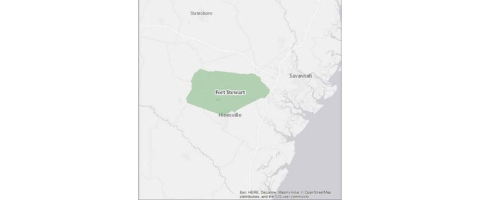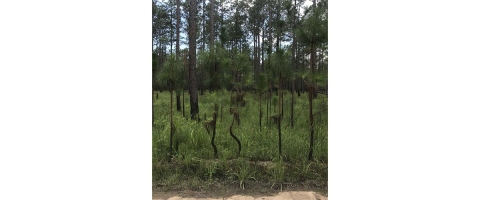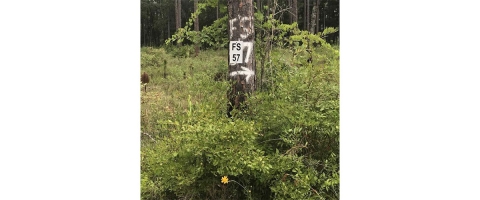Fort Stewart, Georgia — As military partnerships go, this has to be one of the oddest, and strongest. The fighting men and women of the 3rd Infantry Division train alongside… red-cockaded woodpeckers.
Soldiers maneuver the eastern edge of the army base under a canopy of longleaf pine where the iconic woodpeckers make their home. Nearby, tanks prowl and M-16s howl, yet the federally endangered birds flit from limb to limb seemingly without care. In fact, the woodpeckers here are flourishing with populations far surpassing what the military and the U.S. Fish and Wildlife Service agreed upon for their survival 25 years ago.
“Here comes a woodpecker,” said Larry Carlile, a civilian wildlife biologist with the U.S. Army while strolling along a sandy, two-track road through a pristine longleaf stand.
“This is, logistically, a great place to see woodpeckers,” added colleague Tim Beaty, another civilian biologist at Fort Stewart, with binoculars aimed skyward. “We always find them here.”
Beaty and Carlile are the dynamic woodpecker duo credited with growing and sustaining one of the largest woodpecker populations in the Southeast. Their Service-mandated goal for Fort Stewart was 350 “potential breeding groups” of woodpeckers. Today, there are more than 550 groups.
So successful is Fort Stewart that Beaty and Carlile donate, on average, 10 male-female pairs of woodpeckers each year to other federal, state, nonprofit and private landowners.
“I don’t know what it is about Fort Stewart, but if I was a Harvard management guru I’d be doing a study over there,” said Will McDearman, the Service’s red-cockaded woodpecker recovery coordinator. “They’re highly effective in growing the population at a rapid rate. And they continue to do so. Fort Stewart rocks.”
Early conflict turns to cooperation
The woodpecker, a smallish black and white bird with barely visible red marks on the male’s head, was in sad shape in the 1980s. She was listed as an endangered species a decade earlier, with her pine-forest habitat, stretching from southeastern Virginia to east Texas, disappearing under the farmer or developer’s plow. Her numbers dwindled to maybe 3,000 potential breeding groups. (A group consists of an adult female and adult male with or without one or more helpers.) Hurricane Hugo didn’t help. The monster storm came ashore in Charleston in 1989 and decimated pine forests and woodpecker trees in South Carolina and, to a lesser extent, Georgia.
Military installations, with large swaths of undeveloped land and relatively large numbers of woodpeckers, were targeted for recovery operations. The Endangered Species Act, administered by the Service, curtailed training at a half-dozen bases in the Southeast. In 1992, for example, the Service said Fort Stewart’s conservation and protection efforts “jeopardized” the birds’ existence. Training, tanks, trucks, generators and smoke pots were prohibited within 200 feet of a woodpecker cavity. So too was the shooting of 50-caliber weapons. Command posts couldn’t remain in place longer than two hours. Two painted white bands warned soldiers away from cavity trees.
And, “installation biologists saw a need to saturate the landscape with red-cockaded woodpecker [groups] in order to establish populations of sufficient size to ensure viability,” Beaty and others wrote in a 2003 history of woodpecker restoration. “But the military commanders saw a continuing and unacceptable reduction in their ability to conduct realistic training to maintain readiness.”
The generals weren’t happy.
“They’d say, ‘You can’t put woodpeckers here. We need to train here,” Beaty recalled while observing the avian abundance — RCWs, Bachman’s sparrows, hairy woodpeckers, brown-headed nuthatches — at Fort Stewart.
Yet many of the largest woodpecker populations lived on Defense Department installations in Georgia, Florida and North Carolina. And, unlike some federal forests, parks or refuges, the military didn’t routinely manage their lands for the benefit of woodpeckers and other species.
“DOD felt like they were cursed with habitat,” McDearman said. “They felt that they were being punished.”
Something had to be done. Fort Stewart tallied 158 active groups in 1997. The Army and the Service soon developed a strategy to boost woodpecker populations. The tactics were largely twofold: add more birds and improve their habitat. Fire was prescribed for the forests in which the endangered birds lived. Longleaf pine, a woodpecker favorite, was planted. Smaller pines and underbrush were cleared. Young woodpeckers were captured and released on military bases. And biologists implanted thousands of pine trees with artificial cavities — new homes for relocated woodpeckers. Fort Stewart also monitored, for comparison, areas on base not subjected to training restrictions.
“We needed to know how training effects woodpeckers,” McDearman recalled. “What happens when troops maneuver by habitat occupied by woodpecker groups, firing weapons of different sizes? To what extent were we harassing — or killing — woodpeckers as a result of the military presence?”
Beaty, who’d worked with the birds on base since 1977, tallied the study’s results.
“The ones without restrictions,” he wrote, “did as well as the ones with restrictions.”
It was a critical moment in the bird’s recovery.
“We learned that woodpeckers were more tolerant of noise, humans and disturbances than we expected,” said McDearman, who has been coordinating RCW recovery since 2007. “Different kinds of training could occur without adverse impacts.”
Benefitting both training and recovery
Some training restrictions were lifted — Jeeps and Humvees could now maneuver within 50 feet of a cavity tree — much to the generals’ pleasure. The Service said the woodpeckers were no longer in jeopardy at Fort Stewart. By 1998, the base tallied 165 breeding groups. The Army and the Service determined the base should aim for 350 groups.
Beaty was confident Fort Stewart would easily reach that goal — so confident that he began “donating” woodpeckers to other, less-populated regions. Fort Gordon, an Army base in Georgia, got the first pair of birds. Avon Park (Florida), St. Marks National Wildlife Refuge (Florida), Talladega National Forest (Alabama), Silver Lake Wildlife Management Area (Georgia) and numerous others also received woodpeckers from Fort Stewart over the years.
“We’ve given away 433 birds the last two decades and we still have the largest annual average growth rate of any major RCW population,” Carlile said.
Fort Stewart quickly grew its population and was periodically rewarded with the removal of training prohibitions in certain bird-rich areas. It hit the mark in 2012 (383 groups, actually). Training was no longer restricted anywhere on base. Beaty and Carlile, though, didn’t rest on their laurels. Currently, Fort Stewart tallies 550 groups.
“They realized that to extend support for RCW recovery range-wide, not just on their property, would move us all toward recovery faster and benefit not only the species, but enhance military training for everybody too,” McDearman said.
Fort Stewart’s success comes at a critical time. The Service is considering removing endangered-species protections from the woodpeckers or, at least, downlisting the bird from endangered to threatened. Populations across the Southeast continue to rise — up 38 percent over the last 15 years — to more than 7,000 groups. The Service wants to know if military bases, state agencies, nonprofits and private landowners will maintain or continue growing their populations if the bird’s status changes. Fort Stewart is on board and vows to continue placing woodpeckers into deserving homes.
The bird’s long-term survival, though, depends as much upon proper habitat as it does civilian and military assistance. And that means the forests of pine (their understories, in particular) must burn. Fort Stewart carefully torches at least 110,000 acres each year — more than one-third of the base. About 90,000 of the base’s acres are majority longleaf prized by the woodpeckers. And it just so happens that military trainers prefer a wide-open, low-shrub forest as much as finicky woodpeckers.
“Fire is our friend,” Beaty said. “Good management trumps any kind of impact training might have on woodpeckers. Noise, fire, smoke, troops — they don’t bother ‘em.”







